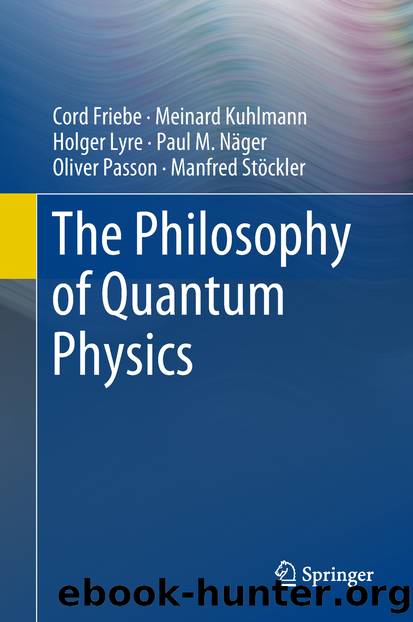The Philosophy of Quantum Physics by Cord Friebe Meinard Kuhlmann Holger Lyre Paul M. Näger Oliver Passon & Manfred Stöckler

Author:Cord Friebe, Meinard Kuhlmann, Holger Lyre, Paul M. Näger, Oliver Passon & Manfred Stöckler
Language: eng
Format: epub
Publisher: Springer International Publishing, Cham
Concerning this last case, we should mention that must no longer describe a state at the source, owing to the abandonment of the locality assumption, and no longer necessarily refers to hidden variables of the photons. From an abstract causal point of view, was from the very beginning simply a hidden common cause of the measurement outcomes and is otherwise a sort of ‘joker variable’ in the diagram. In a local world, a common cause of the measurement outcomes must naturally lie within a section of the past light cone of the measurement outcomes, and the most plausible scenario is that is located at the source, and that it describes hidden variables of the photons. In a non-local world, in contrast, the states which are described by need not lie within the past light cone of the outcomes; instead, they can be found anywhere in the spacetime region between the measurement wings20 (and thus could also be spacelike relative to the outcomes); and nevertheless, they could be the common cause of those outcomes.
The principal problem of the non-local model is that it seems to be in serious contradiction with the concepts of space and time which the theory of relativity suggests. We made use above of the standard interpretation of the theory of relativity, in which the principle of global Einstein locality holds (see Sect. 4.3.1). If, as claimed by this interpretation, it is correct that the principle of global Einstein locality is implied by the theory of relativity, then relativity is truly inconsistent with non-local models. Supporting a non-local model for EPR/B experiments would then mean that one would have to abandon the theory of relativity in a certain sense. Such a radical consequence, however, is avoided by most authors. Their idea is that a solution can be sought which on the one hand saves non-locality, in order to explain the EPR/B correlations, but on the other does not violate the theory of relativity.
Such suggestions have to assume that the theory of relativity does not strictly imply the principle of global Einstein locality. In a certain, limited sense, the theory of relativity must be compatible with the concept that there are influences that propagate faster than light. In the following, we now want to test whether non-local models can be brought into agreement with a relativistic concept of space and time. To this end, we have to look more closely at the question as to what extent the principle of global Einstein locality, which is violated by such models, is indeed founded on the theory of relativity.
First of all, we should say that in classical, pre-relativistic concepts of space and time (cf. Newton’s view), it represents no difficulty if things influence one another at a velocity greater than the speed of light. As long as the velocity with which the influences propagate is finite, there can always be a continuous process from the cause to the effect. Influences between distant events which occur simultaneously , however, exclude such continuous
Download
This site does not store any files on its server. We only index and link to content provided by other sites. Please contact the content providers to delete copyright contents if any and email us, we'll remove relevant links or contents immediately.
The Complete Stick Figure Physics Tutorials by Allen Sarah(7307)
Secrets of Antigravity Propulsion: Tesla, UFOs, and Classified Aerospace Technology by Ph.D. Paul A. Laviolette(5309)
Thing Explainer by Randall Munroe(3877)
The River of Consciousness by Oliver Sacks(3539)
The Order of Time by Carlo Rovelli(3145)
How To by Randall Munroe(3034)
A Brief History of Time by Stephen Hawking(2960)
I Live in the Future & Here's How It Works by Nick Bilton(2935)
The Great Unknown by Marcus du Sautoy(2646)
What If?: Serious Scientific Answers to Absurd Hypothetical Questions by Randall Munroe(2637)
Midnight in Chernobyl by Adam Higginbotham(2483)
Blockchain: Ultimate Step By Step Guide To Understanding Blockchain Technology, Bitcoin Creation, and the future of Money (Novice to Expert) by Keizer Söze(2445)
Networks: An Introduction by Newman Mark(2360)
The Meaning of it All by Richard Feynman(2300)
Easy Electronics by Charles Platt(2281)
The Tao of Physics by Fritjof Capra(2229)
Midnight in Chernobyl: The Untold Story of the World's Greatest Nuclear Disaster by Adam Higginbotham(2177)
When by Daniel H Pink(2082)
Introducing Relativity by Bruce Bassett(2076)
